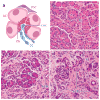Regeneration and repair of the exocrine pancreas
- PMID: 25386992
- PMCID: PMC4324082
- DOI: 10.1146/annurev-physiol-021014-071727
Regeneration and repair of the exocrine pancreas
Abstract
Pancreatitis is caused by inflammatory injury to the exocrine pancreas, from which both humans and animal models appear to recover via regeneration of digestive enzyme-producing acinar cells. This regenerative process involves transient phases of inflammation, metaplasia, and redifferentiation, driven by cell-cell interactions between acinar cells, leukocytes, and resident fibroblasts. The NFκB signaling pathway is a critical determinant of pancreatic inflammation and metaplasia, whereas a number of developmental signals and transcription factors are devoted to promoting acinar redifferentiation after injury. Imbalances between these proinflammatory and prodifferentiation pathways contribute to chronic pancreatitis, characterized by persistent inflammation, fibrosis, and acinar dedifferentiation. Loss of acinar cell differentiation also drives pancreatic cancer initiation, providing a mechanistic link between pancreatitis and cancer risk. Unraveling the molecular bases of exocrine regeneration may identify new therapeutic targets for treatment and prevention of both of these deadly diseases.
Keywords: acinar cell; caerulein; cerulein; differentiation; inflammation; metaplasia; pancreatitis.
Figures



References
-
- Steinberg WM. Acute Pancreatitis. In: Sleisenger MH, Feldman M, Friedman LS, Brandt LJ, editors. Sleisenger & Fordtran’s gastrointestinal and liver disease: pathophysiology, diagnosis, management. Philadelphia: Saunders; 2006.
-
- Pan FC, Wright C. Pancreas organogenesis: From bud to plexus to gland. Dev Dyn. 2011;240:530–65. - PubMed
-
- Shih HP, Wang A, Sander M. Pancreas organogenesis: from lineage determination to morphogenesis. Annu Rev Cell Dev Biol. 2013;29:81–105. - PubMed
-
- Kretzschmar K, Watt FM. Lineage tracing. Cell. 2012;148:33–45. - PubMed
Publication types
MeSH terms
Grants and funding
LinkOut - more resources
Full Text Sources
Other Literature Sources

